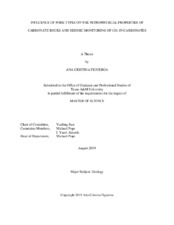| dc.description.abstract | Carbonate rocks are a significant component of future petroleum endeavors, but due to complex pore geometries display a lower average recovery factor in comparison to sandstone reservoirs. To recover residual oil and gas in these reservoirs, CO2 enhanced oil recovery (EOR) is required. The theoretical results of this quantitative study are designed to provide a better understanding of the influence of carbonate rock pore types on seismic monitoring of CO2 flooding in carbonate reservoirs. This research shows how carbonate rock pore types influence the petrophysical properties, as rocks with the same porosity can have very different velocities. Rock physics models, like the Sun (2000) model, were used to quantify the carbonate rock pore types. The elastic parameter, frame flexibility factor, provide a structural representation of the pore. High frame flexibility factors correlate with rocks that have more grain coupling and contacts, such as intercrystalline and microporosity samples. Low frame flexibility factors relate to a rigid rock frame, present in cemented and moldic pore types. CO2 flooding causes a decrease in Vp and bulk modulus, the largest change occurring in microporous rocks. Average microporosity samples had about a -13% Vp change for CO2 gas, whereas it was a -11% Vp change for CO2 liquid. Of the petrophysical properties, the largest percent change was for the bulk modulus of microporosity pores, with a -32% change for CO2 gas and -26% change for CO2 liquid. CO2 liquid flooding causes an increase in Vs due to the density effect. The CO2 flooding effect percent changes were higher for CO2 gas-saturated than for CO2 liquid-saturated samples. Samples used had the same porosity of about 40%, as well as similar mineralogy, therefore the changes in pore types caused the changes in CO2 flooding. For CO2 gas, the percent changes in the CO2 flooding effect display a negative change for all properties except density and impedance, where the change was positive.
The CO2 flooding effect percent changes for CO2 liquid, shows a negative change for all properties except Vs, where the change was positive. The changes that occur with CO2 flooding are due to the density effect associated with the CO2 phase changes. The results of this thesis provide significant conclusions that could be used as a guide for future researches on time-lapse seismic monitoring of carbonate rocks following CO2 sequestration. An effective rock physics model can better determine and aid in understanding the effects carbonate rock pore geometries have on seismic monitoring of CO2 sequestration in carbonate rock reservoirs. | en |


